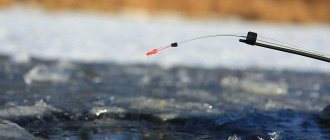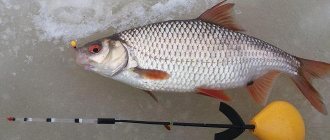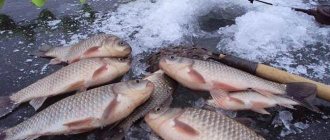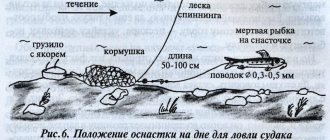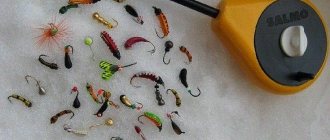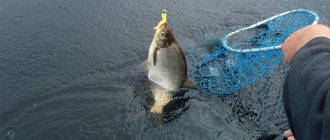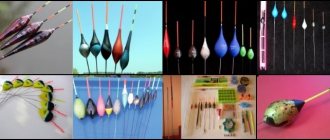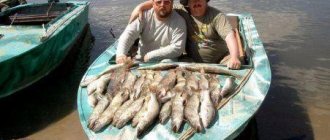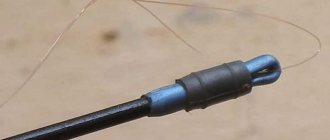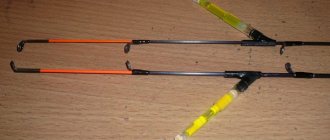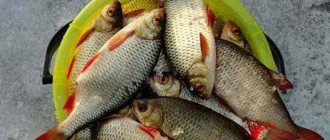Active jig fishing in the current sometimes turns into a stumbling block. And fishermen avoid such river places. However, small and medium-strong currents in winter can bring catches even better than fishing in still water. There are no special or special jigs for fishing on currents in winter - it’s all about the equipment and the correct technique. Sometimes subglaciers make the mistake of using the usual jig for still water throughout the current. This is the reason for the failures. Deadlift work requires a different approach. And these efforts will pay off - there are more fish on the riverbed in winter, and larger specimens are caught. You just need to slightly change your approach to technology and equipment.
Features of fishing on the current
At great depths under traction conditions, standard thin equipment and a small jig do not work. More precisely, it can only be used in very weak currents, as long as the strength of the flow allows you to control the bottom with the bait. For stronger traction, you need to use heavy jigs, special equipment, or generally fish with a riser or with winter ice bottoms. And if the main places for ice fishing in winter are rivers, then you need to think about an integrated approach. That is, to be armed with various methods and gear, using them depending on the strength of the current.
The current forces the use of heavier and less sensitive equipment - and this is often a stumbling block for seasoned jig fishers, but only in reservoirs with standing water or weak draft. However, there is no other way out - the strength of the flow does not allow the use of ultra-sensitive standard jig equipment and a pool of familiar fishing rods, which fishermen have their hands full with. What saves the situation is the fact that the fish are active on the stream. In order to stay in the flow, underwater inhabitants expend a lot of effort; the oxygen regime in such places is normal, and as a result, the fish actively feed. Its bites in such places are more daring and bold. There is simply no time to savor every bit of food - otherwise the fish will remain hungry.
Active jig
We discussed stationary ice fishing with fishing rods in the current in the article at the link provided. Here we will analyze active fishing for the game with one fishing rod, with constant control of the gear. The bottom line is that fishing conditions should be divided into two types - depending on the ability to control the bottom with the gear used for fishing. In weak currents (or medium currents with shallow depths), you can work with the usual gear, including baitless bait, only heavier (from 0.5 grams). In strong currents, a heavy sinker is included in the rig. The game is played by tensioning and releasing a loop of fishing line, inflated by the current, without lifting the heavy sinker from the bottom (in place) or by releasing it (pull) under the ice. By the way, it is advisable to use these two fishing methods on the same gear.
Bottom control
The success of playing a jig in the current with conventional equipment is based on two pillars - correct installation and special play for these conditions. Standard saw, herringbone and dribbling do not work. You just need to not curse the flow in your head, but find a common language with it and use the physical properties of the flow.
The selection of the nod, the thickness of the fishing line and the weight of the jig is carried out so that the tackle is held at the bottom after lowering. At the same time, when lifting the gear, for example, 20 cm from the bottom, the working descent increased by 10 cm (50%). Accordingly, this distance will need to be lowered from the reel - this means that the jig has been pulled further under the ice by the current (but is not carried - the bait has stopped again). The difficulty is that such gear cannot be prepared at home in advance - all manipulations are carried out already on the reservoir, at a specific depth and strength of the current. You need to take a thin fishing line - it simply has less windage, therefore, such a monofilament is not strongly inflated by the current. Alternatively, instead of one heavy jig, you can use a steam locomotive of 2-3 smaller ones.
Traditional fishing on the rise is not used. In the current, we catch it on release, tugging the tackle in small steps. At the same time, the jig moves under the ice a little further each time. It is at this lowering after rising that 90% of bites occur. The drag limit is determined by the nod - you can let go as long as the bait is felt. Then, in the reverse order, we raise the fishing rod, but now we don’t lower it, but wait until the jig goes to the bottom against the current. Thus, you can’t work with high-frequency oscillations here - you get rises and falls of the jig, slowed down by the current. At the same time, even when stationary, the bloodworm on the hook moves, which additionally attracts fish.
Playing on a loop
In a strong stream, on which even a tungsten jig cannot hold, a heavy sinker is added to the rig at the end of the fishing line. A working jig (heavy fly) is tied 30-40 cm higher by a locomotive or on a lead leash. Soft nods are not suitable for such fishing, nor are too hard ones. The desired option can only be selected experimentally. The game is a careful pulling of a line loop inflated by the current without lifting the sinker from the bottom and releasing it back. At the same time, the jig moves diagonally to the bottom (if it’s heavy, it can even reach it) and back. This method is used to catch roach and grayling in the current. However, it is still better to place the jig on a retractable leash. In this case, if there are no bites on the tension, we switch to catching without changing the equipment. At the same time, the sinker is still selected not too large, usually 10-20 grams. With enough lift, it should come off the bottom and be pulled under the ice.
Pull (let down)
Winter fishing with a jig on the current in the winter by pulling is carried out in the same way as rolling with bottom tackle. In essence, it’s the same thing, it’s just that on the leash it’s not a hook with bait, but a jig. The installation was not carried out inline (sliding), but on a branch lead. The sinker with the leash moves further with the current. In this case, it is important to catch the rhythm of the nod movement. A bite is often noted as a delay in the movement of the guard. The leash with the jig is freely stretched by the current and does not get tangled with the main fishing line. The main thing is to make the twitches smoothly and briefly, without sharp and long jerks. The farther from the hole, the more amplitude the swing of the hand is - after all, you also need to select a loop of fishing line from the stream. And so on to the limit - arms raised above the head at the top point of the swing at the farthest distance. Then - in reverse order. In this way, a large area of water is fished - up to 20 meters downstream.
jig fishing technique
- Having found the desired depth of descent, place one or more bloodworms, burdocks or mayflies on the jig. The jig is lowered to the bottom, controlling the descent with a nod. Then shake the jig at the bottom, knock 5-10 times so that a cloud of turbidity rises. Start lifting with rocking at a fast pace with an amplitude of oscillation of the rod tip of 1.5 cm. Raise the jig to a height of 50 cm and wait a pause of 2-3 seconds. Lower the jig to the bottom on a bent nod. After 5-10 cycles, you need to try to change the pace of the game and reduce the amplitude of vibrations, raise the jig higher.
- Lower the jig with bait to the bottom. Raise the jig 1-3 cm and begin a leisurely rise, playing with the tip of the fishing rod at a pace of 90-120 times per minute and an amplitude of 0.5-1 cm. Stop the rise every 3-5 cm, shaking the jig 2-3 cm. At a level of 60-70 cm from the bottom, finish lifting and lower the jig for a new cycle.
- Lower the jig to the bottom. Swing the jig, lifting it 0.5-1 cm above the bottom. After 3-4 cycles, pause for 5-7 seconds. All movements should be slow. After 1-2 minutes, direct the fishing line to the edge of the hole. Without stopping playing with the jig, pull the line to the other edge of the hole. This is a good technique for fishing with a jig when the fish are sluggish in the dead of winter.
- Lower the jig to the bottom. Raise it 3-5 cm and play it like a spinner 3-5 times. Hang above the bottom and pause for 2-4 seconds. Start lifting, slowly accelerating, and leave the jig 40-50 cm above the bottom. Then lower it in jerks by 2-3 cm with a pause of 2-3 s. Leave on the bottom for 3-4 seconds. This technique of fishing with flat jigs is suitable when the fish is quite active.
- Reelless fishing with a jig . The jig sinks to the bottom. Then a slow rise begins with trembling oscillations, the rate of which is 100-300 times per minute, the amplitude is no more than 1 cm. The slower the rise and the shorter the amplitude of the oscillations, the more often fish bites occur. If there is a failure in tempo, it is better to start lifting the jig from the bottom again. This technique of fishing with a jig brings success all winter, with the exception of the middle of winter - the time when fish are most unbiting.
- The jig is raised above the bottom by 0.6-1 m, and the game begins. The jig is lowered by 2-3 cm and, holding it, pause for 2-3 seconds. During the pause, they rock gently. Having reached the bottom, pause for 3-4 seconds and move the jig, repeating this 5-6 times. The jig is slowly lifted from the bottom 0.5-1 m.
- The jig is lifted from the bottom slowly. Swing the tip of the winter fishing rod at a rate of 10-20 times per minute with an amplitude of 2-3 cm. Stop the rise after 15-20 cm and pause for 2-4 s. You can not raise it above 60 cm.
- Moving the jig on the bottom, he moves the tip of the winter fishing rod from edge to edge of the hole crosswise. This jig fishing technique is called “crossing the hole.” White bream, ide and chub are caught.
This jig fishing technique is not exhaustive. An angler can look for his jig fishing technique. But we must also be guided by general principles. The technique of fishing with a jig should depend on the time of year, the fish you are going to catch, and the weather. If there is no oxygen deficiency in the reservoir, when there is first ice or in the spring, jig play can be more active. If there is a lack of oxygen and fishing with a jig in the middle of winter, before the snow begins to melt, it is necessary to sharply reduce the amplitude of oscillations of the winter fishing rod and reduce the activity of the game.
Search tactics
Everything we have considered assumes that the angler is at a known catch point. That is, this is the final stage - a place has been found and fishing takes place. It’s good if the reservoir is “home” and the points are known. If not, a huge amount of time can be spent searching for fish. Search tactics are directly related to the bait system. Holes are drilled in the selected water area, usually at different depths, and fed. Then you need to devote time to each one and fish it in order to find out in principle whether it bites or not. If the results are positive, we feed thoroughly. In a weak current, the bait can be lowered directly into the hole, in a strong current - in a special large feeder. The fisherman’s task is to combine the eroded spot and the fishing line with the tackle. Fish do not wander far in winter, preferring not to waste extra energy. And it will stand right on the stern strip, where edible particles rush along the bottom and in the depths, getting stuck in uneven areas.
All fishing with a jig in a strong current comes down to this combination of factors - stopping the fish at a specific point (with the help of bait) and bringing the hooks with bait to this nickel of the bottom. If you miss by a meter or two, you may not get a single bite (in the worst case, if there is no active fish).
Top 7 effective jig playing techniques
Winter fishing is good because at this time anglers are puzzled by finding the right approaches to fish, testing various hypotheses regarding its mood at the moment and food preferences. Fishing becomes more exciting in the dead of winter - when using jigs. Often, in order to interest sluggish fish, you have to try different tactics, which we will talk about today.
Stirring at the bottom
This technique is most suitable for bream, perch and roach. The whole game takes place right at the bottom. Here are its elements:
- constant movement;
- occasional lifting of a couple of centimeters with continued oscillations;
- infrequent short breaks. Stops are made both at the bottom and above it.
Ascent and descent with oscillations
The starting point for this type of play is the bottom. The bait is lowered to the surface, hit the bottom several times and rises. During the climb, it is important to maintain an average speed. Short, small-amplitude nodding oscillations are periodically performed.
The jig stops half a meter from the bottom, and after 3-5 seconds it descends at the same speed and with regular oscillations.
This whole cycle is repeated several times. After every two attempts, the amplitude and frequency of oscillations change. It is desirable that the speed of the bait remains the same.
The fish often bites either during the rise or when the bait is immersed. This suggests that you need to hook without delay, otherwise the prey will leave.
Lifting with pushes
The game starts from the bottom. The jig rises smoothly and slowly, as in the previous case. True, fluctuations are reduced to a minimum. You just need to lightly twitch the jig every 6-7 cm of rise. For the fish, this creates the appearance that some living creature is swimming away in the water, pushing away from it. This game usually attracts perch.
Read: Fishing on first ice. Subtleties and nuances
To make playing with a jig more effective, when lifting or sinking the bait, move the line from one edge of the hole to the opposite and back. What do we get? Oscillations, stops and movement in the vertical plane are complemented by horizontal movement. A reasonable solution would also be to slightly widen the hole. After this, horizontal movements will become more distinct. This tactic is more effective on sunny days. At this time, the fish hides from the light and stays away from the hole. It is the horizontal movements of the jig that allow you to bring it closer to the fish. At great depths, it is very difficult to regulate the movement of the jig in this way. This method should not be used in reservoirs over 3 meters deep.
Lifting with preliminary vibrations
This method is in many ways similar to those described above. You also need to play from the bottom. But instead of knocking, you need to raise the jig a couple of centimeters above the soil surface and perform frequent vibrations - about a hundred per minute. Such active fuss can intrigue the fish.
After this, slowly and carefully lift the bait. Every 10 cm, stop the jig and perform a short series of smooth oscillations. It is at this moment that a bite may follow. The maximum lifting height is about half a meter.
Ascent and descent with frequent oscillations
Again, the jig is driven from the very bottom. The rise should be smooth and slow. In this case, no pauses or twitches are needed. It is only important to constantly hit the rod with your finger while moving. The same should be done during a dive. Thanks to these blows, the jig constantly vibrates and trembles, which invariably attracts fish.
Read: Pike fishing in January
Ascent with acceleration and descent with pauses
This game is especially effective for winter predators: pike, pike perch and perch. Again, it starts from the very bottom.
The jig rises, twitches strongly several times and rises with acceleration.
Stop at a height of 50 cm, and after a short pause, lower the jig back. Stop it periodically.
Bottom races
This technique is somewhat similar to the first strategy for attracting the attention of fish, but this technique is recommended for catching perch. The fuss that attracts fish also occurs at the very bottom. Interestingly, this is a successful fishing method for beginner fishermen, since it does not require much effort and practice.
The order of the game is very simple: you need to make several hits on the bottom of the reservoir - 5-8 is enough. After this, the jig slowly rises above the bottom - a maximum of 7 cm. A pause is made at the highest point of the rise. After this, the bait calmly returns to the bottom.
From the “Did you know” section
Fans of pike will find it interesting and useful to know its behavior during a thaw. At this time, the predator becomes more active. It is attacked by zhors, and therefore it is more often found among fishermen. However, the thaw was different.
The main winter prey of pike is fry, so the behavior of the predator is determined by the reaction of the small fish to weather changes.
In the case of a short-term, 2-3-day thaw, pike, like small fish, stick to watering at medium depths, edges and snags near the riverbed.
During a prolonged thaw, small fish “graze” off the coast. Naturally, there is also pike here.
So, in addition to weather reports, it is important to take into account the duration of the established weather.
Where to look for a predator when the thaw is accompanied by rain? The ice often melts at this time, and streams rush into the reservoir, saturating the coastal areas with oxygen. For this reason, the fry ends up almost at the very shore. You need to look for pike side by side at a depth of 0.3-0.5 meters.
Read: How and with what to insulate a winter tent?
A few words about safety
According to medical statistics, in winter the likelihood of street injuries is three times higher than in warm weather. 15% of visitors to doctors' offices are people with bruises, sprains and fractures. Moreover, a fifth of these patients remain disabled. For fishermen, such an unpleasant prospect is even more likely.
Factors that increase the likelihood of injury:
- rush;
- inattention;
- uncomfortable and slippery shoes;
- low or overweight;
- heavy burden.
Prevention of injuries on the reservoir:
- during icy conditions, bypass areas not covered with snow;
- moving on slippery ice with a “ski gait”;
- using flat-soled shoes or a pair with a small square heel;
- equipping slippery soles with special heels;
- buying snowshoes. These are elastic bands with spikes that are worn over boots. With them, going out on the ice is no longer scary: the spikes cut into the icy surface, and you definitely won’t lose your balance. You can find them in any sports store. True, they are not so cheap, but they only last for a season.
Snowshoes can be replaced with old nylon tights. After putting them on the shoes, the slipping stops.
What to do if a fall is inevitable? If there is no possibility of restoring balance, you need to group:
- sit down or fall so that the load is taken by the shoulder, forearm or shoulder blade;
- protect your face with your hands;
- place your elbows at chest level, and when falling on your back, spread your arms as wide as possible;
- press your chin to your chest.
